|
Surveillance images taken by spy planes and satellites have been
used to sway public opinion ever since President John F. Kennedy
declassified U-2 images of Russian nuclear missiles in Cuba four
decades ago. Since then, the release of such
photographs—sometimes officially sanctioned, sometimes
not—has played a crucial role in geopolitics, never more
intensely than in recent years. In this interactive satellite map of
the world, examine a series of influential images released between
1962 and 2005.—Tim Brown
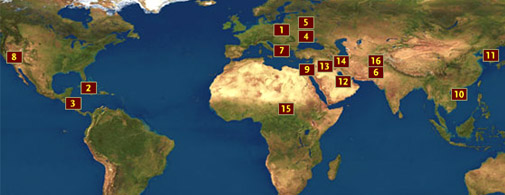
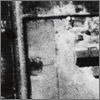

|
|
1. Poland, 1944
Disturbing as they are, aerial images like this one of the
Nazi death camp at Auschwitz had no effect on the camp's
operations after they were taken, because the photos were
collected incidentally as part of bomb-strike imagery of the
nearby IG Farben chemical plant. CIA photo interpreters
discovered the imagery decades later. Aerial photos like this
one were the precursors to far more sophisticated satellite
imagery to come.
|
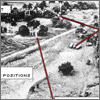

|
|
2. Cuba, 1962
During the Cuban Missile Crisis, President Kennedy
declassified this image and others like it showing
construction of medium-range ballistic missile launch sites in
the Cuban countryside. Kennedy used the imagery to generate
support for a military blockade and military strikes against
Cuba. Target audiences included the Soviet leadership and the
general public, both domestic and international.
|
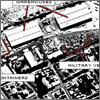

|
|
3. Nicaragua, 1982
This image, taken by an American SR-71 spy plane, shows Soviet
merchant ships unloading military equipment at the Nicaraguan
port of Corinto. The U.S. State Department Office of Public
Diplomacy released this image of the Nicaraguan military
buildup to generate support for the "contras" and to highlight
the threat posed by the Soviet Union, Cuba, and Nicaragua of
fomenting revolution throughout Central America.
|
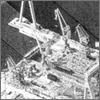

|
|
4. Soviet Union, 1983
The defense magazine Jane's Defense Weekly published
highly classified satellite imagery of a Soviet aircraft
carrier under construction at the Nikolaev shipyard on the
Black Sea. The images, including this one, were taken by an
American KH-11 reconnaissance satellite. Leaked by U.S. naval
analyst Samuel Morison, the images gave the general public
around the world a first glance at the capability of America's
classified reconnaissance satellites. The resolution of this
image is about one and a half to three feet per pixel; when
the satellite is directly overhead, it can resolve objects
four to six inches in diameter.
|
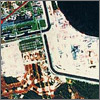

|
|
5. Soviet Union, 1986
Imagery taken by the French satellite SPOT marked the first
use of commercial satellite imagery by a news organization
(ABC News) to independently confirm a major news story. This
was significant because the Soviets were denying that the
nuclear accident at Chernobyl had taken place. Satellite
imagery, it was now clear, could show events and places in
countries where the news media was denied access. This is a
combined SPOT-Eosat image of Chernobyl; the red dot is a
thermal signature revealing the extreme heat of the reactor
meltdown.
|
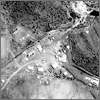

|
|
6. Afghanistan, 1998
The U.S. released images from what it called Operation
Infinite Reach, including this image of an Al Qaeda training
camp at Zhawar Kili in Afghanistan that was later bombed. This
release, which also included the image of a suspected
biological warfare production plant at Shifa, Sudan, was the
first official release of previously classified satellite
imagery by the U.S. government.
|
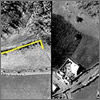

|
|
7. Kosovo, 1999
In April 1999, officials of the North Atlantic Treaty
Organization, or NATO, released this pair of aerial
photographs taken high above Izbica in western Kosovo, showing
what NATO claimed may be a mass grave containing 150 bodies.
NATO officials cited these photographs as evidence that Serb
forces were summarily executing civilians.
|


|
|
8. United States, 2000
The Public Eye project of the Federation of American
Scientists ordered this IKONOS satellite image of the secret
U.S. airbase called Area 51—located at Groom Lake,
Nevada—to test the limits of the government's
"shutter-control" policy. Groom Lake is one of America's most
sensitive and closely guarded military flight test centers.
After a two-month delay that included the release of a
two-meter Russian image, Space Imaging, which is a subsidiary
of defense contractor Lockheed Martin, finally released the
image. The hangar seen here is configured to allow an aircraft
within to taxi or "drive-thru" with its engines running, out
of view of prying satellite eyes. The horizontal black line at
the bottom center of the image is a blast deflector, which
enables the hidden aircraft to run its engines to full power
without damaging nearby buildings or vehicles.
|
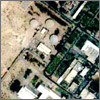

|
|
9. Israel, 2000
The existence of Israel's nuclear program is officially denied
by the Israeli government for fear of mandatory U.S. trade and
diplomatic sanctions that would be imposed if proof of the
program were to become public. Israel has not signed the
nuclear nonproliferation treaty, and the U.S. officially turns
a blind eye to Israel's weapons-of-mass-destruction (WMD)
program. The release of this IKONOS image of the Israeli
nuclear reactor at Dimona caused some embarrassment for both
Israel and the U.S. The reactor is in the lower left of this
image.
|
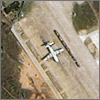

|
|
10. China, 2001
After a Chinese fighter jet collided with a U.S. EP-3 Aries
reconnaissance aircraft in international waters off China,
this IKONOS image of the crippled U.S. plane sitting on the
parking ramp of an airbase on China's Hainan Island shortly
after it landed there became an icon for the crisis between
the U.S. and China. (The Chinese pilot ejected from his plane,
which then crashed in the ocean, but he was never found.) The
image also demonstrated the ability of commercial satellite
imagery to quickly tell a story in a denied country. The
Chinese government eventually allowed U.S. officials to
dismantle and retrieve the plane using a Russian transport
aircraft.
|
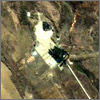

|
|
11. North Korea, 2001
This IKONOS commercial satellite image of North Korea's No
Dong missile test pad represented the first use of
high-resolution commercial satellite imagery by a
non-governmental organization (NGO) to independently examine a
facility that concerned the U.S. intelligence community. The
Federation of American Scientists ordered and published this
image to influence public opinion. This and related images
revealed that No Dong is rather unimpressive compared to
missile launch sites in other countries; it's smaller, for
instance, and has only a dirt road leading to it. Hardliners
in the U.S. government who had been agitating about the North
Korean missile program withheld releasing the image out of
concern that the public might conclude that the North Korean
missile program was not as advanced as the intelligence
community and legislative supporters of missile defense
claimed. In the image, the circle in the center is the missile
launch platform, while the diagonal dark rectangle below it is
the shadow cast by the missile erector.
|


|
|
12. Qatar, 2002
Taken by DigitalGlobe, a commercial satellite company, this
image of the U.S.-leased Al Udeid airbase in the tiny Persian
Gulf country of Qatar quickly and visibly drew domestic and
international attention to the ongoing U.S. military buildup
in the Persian Gulf in preparation for a possible war with
Iraq. The image, which the GlobalSecurity.org Web site made
public, was the single most requested image in the Web site's
history, generating stories by major U.S. and foreign
broadcast, print, and other media. The planes to the right are
KC-135R Stratotanker refuelers, while the lone plane to the
left is a C-17 Globemaster transport.
|
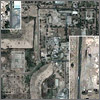

|
|
13. Iraq, 2002
GlobalSecurity.org posted this image showing new construction
(in enlarged boxes) at the Tuwaitha nuclear research center
southeast of Baghdad, Iraq. The Iraqi Foreign Ministry
immediately responded by showing a picture of the image at a
press conference and denying that the facility was being used
for military purposes. The Iraqis then led Western journalists
on a carefully controlled guided tour of portions of the
facility to demonstrate that it did not have WMD function. The
release of the Tuwaitha image marks the first time that an NGO
has successfully used commercial imagery to influence the
behavior of a country believed to be illegally pursuing a WMD
capability.
|
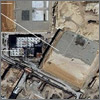

|
|
14. Iran, 2003 & 2005
This hardened underground uranium enrichment facility near the
city of Natanz, Iran illustrates both the ability to detect
construction of ongoing nuclear facilities and the limits of
imagery to divine political intentions. Did the Iranians
construct this hardened underground facility knowing that it
would be used in a nuclear weapons program? Or was it part of
a peaceful, commercial nuclear fuels program and they feared
it would be attacked if aboveground? The imagery alone has yet
to solidify international resolve.
|
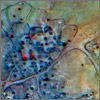

|
|
15. Sudan, 2004
Commercial satellite imagery can identify ethnic cleansing and
humanitarian crises when "cued" (or supplied precise
coordinates on where to point a satellite) by other sources,
including humanitarian relief organizations and NGOs on the
ground. Unfortunately, while convincing to expert eyes, the
images alone may not be persuasive enough to help solve such
crises. A glaring case in point is imagery of Darfur released
by the U.S. State Department in 2004 (left) and by
humanitarian groups in 2007, which has not succeeded in
motivating international organizations to apply the necessary
political pressure and sanctions on the Sudanese government to
end what appears to be genocide. In a case such as that in
Darfur, "ground-truth" imagery, when available from on-site
sources, is often more dramatic and thus more persuasive in
making the case of genocide than blurry images from orbit. In
this detail from an image of a destroyed village near Shataya
in Darfur taken on June 21, 2004, black rings are foundations
of destroyed huts, while red areas indicate remaining healthy
vegetation.
|
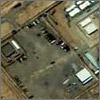

|
|
16. Afghanistan, 2005
Overhead imagery of a CIA Field Station north of Kabul,
Afghanistan helped illustrate and draw international attention
to a secret CIA program known as "extraordinary rendition." In
this program, battlefield combatants were interrogated and
later transported to countries where interrogation methods
were harsher than those permitted under U.S. law. This CIA
station was located only after the general description of the
facility's location was "leaked" by a knowledgeable insider in
the U.S. intelligence community.

|
Tim Brown is a senior fellow at GlobalSecurity.org, a nonprofit
think tank that supports the use of space technology to enhance
international peace and security. The author stresses that
successful identification of objects and activities in images like
the ones appearing in this feature requires the trained eye of an
expert (see, for example,
Master of the Surveillance Image) and is often clinched with supplementary information, such as
that collected by spies on the ground. Note: This feature has been
updated from a version called "Spy Photos That Made History" that
appeared on this page until December 2007. This new version appears
also on NOVA's Astrospies Web
site.
|

We recommend you visit the
interactive version. The text to the left is provided for printing purposes.
|



